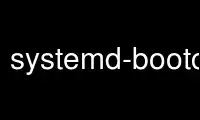
This is the command systemd-bootchart that can be run in the OnWorks free hosting provider using one of our multiple free online workstations such as Ubuntu Online, Fedora Online, Windows online emulator or MAC OS online emulator
PROGRAM:
NAME
systemd-bootchart - Boot performance graphing tool
DESCRIPTION
systemd-bootchart is a tool, usually run at system startup, that collects the CPU load,
disk load, memory usage, as well as per-process information from a running system.
Collected results are output as an SVG graph. Normally, systemd-bootchart is invoked by
the kernel by passing init=/lib/systemd/systemd-bootchart on the kernel command line.
systemd-bootchart will then fork the real init off to resume normal system startup, while
monitoring and logging startup information in the background.
After collecting a certain amount of data (usually 15–30 seconds, default 20 s) the
logging stops and a graph is generated from the logged information. This graph contains
vital clues as to which resources are being used, in which order, and where possible
problems exist in the startup sequence of the system. It is essentially a more detailed
version of the systemd-analyze plot function.
Of course, bootchart can also be used at any moment in time to collect and graph some data
for an amount of time. It is recommended to use the --rel switch in this case.
Bootchart does not require root privileges, and will happily run as a normal user.
Bootchart graphs are by default written time-stamped in /run/log and saved to the journal
with MESSAGE_ID=9f26aa562cf440c2b16c773d0479b518. Journal field BOOTCHART= contains the
bootchart in SVG format.
INVOCATION
systemd-bootchart can be invoked in several different ways:
Kernel invocation
The kernel can invoke systemd-bootchart instead of the init process. In turn,
systemd-bootchart will invoke /lib/systemd/systemd.
Started as a standalone program
One can execute systemd-bootchart as normal application from the command line. In this
mode, it is highly recommended to pass the -r flag in order to not graph the time
elapsed since boot and before systemd-bootchart was started, as it may result in
extremely large graphs. The time elapsed since boot might also include any time that
the system was suspended.
OPTIONS
These options can also be set in the /etc/systemd/bootchart.conf file. See
bootchart.conf(5).
-h, --help
Print a short help text and exit.
-n, --sample N
Specify the number of samples, N, to record. Samples will be recorded at intervals
defined with --freq.
-f, --freq f
Specify the sample log frequency, a positive real f, in Hz. Most systems can cope with
values up to 25–50 without creating too much overhead.
-r, --rel
Use relative times instead of absolute times. This is useful for using bootchart at
post-boot time to profile an already booted system. Without this option the graph
would become extremely large. If set, the horizontal axis starts at the first recorded
sample instead of time 0.0.
-F, --no-filter
Disable filtering of tasks that did not contribute significantly to the boot.
Processes that are too short-lived (only seen in one sample) or that do not consume
any significant CPU time (less than 0.001 s) will not be displayed in the output
graph.
-C, --cmdline
Display the full command line with arguments of processes, instead of only the process
name.
-g, --control-group
Display process control group
-o, --output path
Specify the output directory for the graphs. By default, bootchart writes the graphs
to /run/log.
-i, --init path
Use this init binary. Defaults to /lib/systemd/systemd.
-p, --pss
Enable logging and graphing of processes' PSS (Proportional Set Size) memory
consumption. See filesystems/proc.txt in the kernel documentation for an explanation
of this field.
-e, --entropy
Enable logging and graphing of the kernel random entropy pool size.
-x, --scale-x N
Horizontal scaling factor for all variable graph components.
-y, --scale-y N
Vertical scaling factor for all variable graph components.
OUTPUT
systemd-bootchart generates SVG graphs. In order to render those on a graphical display
any SVG capable viewer can be used. It should be noted that the SVG render engines in most
browsers (including Chrome and Firefox) are many times faster than dedicated graphical
applications like Gimp and Inkscape. Just point your browser at file:///run/log/!
HISTORY
This version of bootchart was implemented from scratch, but is inspired by former
bootchart incantations:
Original bash
The original bash/shell code implemented bootchart. This version created a compressed
tarball for processing with external applications. This version did not graph
anything, only generated data.
Ubuntu C Implementation
This version replaced the shell version with a fast and efficient data logger, but
also did not graph the data.
Java bootchart
This was the original graphing application for charting the data, written in java.
pybootchartgui.py
pybootchart created a graph from the data collected by either the bash or C version.
The version of bootchart you are using now combines both the data collection and the
charting into a single application, making it more efficient and simpler. There are no
longer any timing issues with the data collector and the grapher, as the graphing cannot
be run until the data has been collected. Also, the data kept in memory is reduced to the
absolute minimum needed.
Use systemd-bootchart online using onworks.net services
